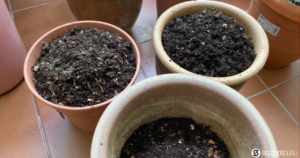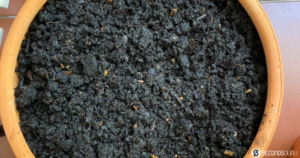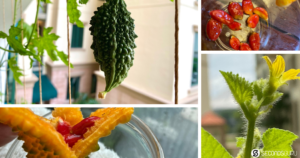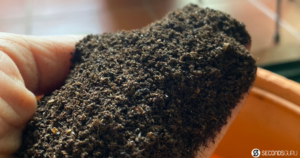Published 10 February 2021 ● Last Updated on 14 August 2023
Today’s article comes from the pen of Sulata Maheshwari, whose apartment in Singapore hosts composting pots in the balcony, a range of edibles across all window sills and absolutely NO raw fruit/veg waste in the kitchen!
“I spent a third of my childhood in my family’s village farmhouse watching the cyclical process of growing food,” says Sulata. “The connection to the earth was rekindled when I grew a Holy Basil sapling in Hong Kong with seeds brought from my village, Shyampur.” Fast forward to 2015, Sulata started composting, taking care “to grow and not throw the end products of our consumption.”
Sulata is also a walkaholic, and you can catch some of her favourite hikes here.
My composting experience is pretty much like my learning-to-cycle experience.
I started very late-after I was 40, I didn’t bother to educate myself, I tried whatever made sense to me, fell and got hurt a few times (after 40, the hurt really hurts!), understood what not to do after a few attempts and then started asking people what they did. Anyone reading this, is thus ahead of where I was when I started and unlike me, is not starting to read a book from the last page.
So I can confidently say today, there are no really bad mistakes you can make in composting. Raw, organic matter will decompose in a hot and humid country – in spite of our slips here and there. I will take you through my journey and hopefully you will enjoy the ride with a few eye-rolls at how dumb some of my mistakes were. But do note, what I practice relates to the method of aerobic composting using raw, kitchen waste of veggies/fruits and no animal/dairy products. There are so many ways to compost – and even within the aerobic form, many styles are successful. My learnings may not hold true for other forms of composting like anaerobic, bokashi, vermicomposting, etc.
To share my way of composting, I am avoiding a step-by-step guide in this article. Instead I offer pit-stops in my journey of composting which gave me insights on the decomposition process, and really improved my success in gaining black gold. Read on to avoid my missteps and get answers to some FAQs that every composter fields.
Insects and Flies
My first attempt, back in 2014, without doing any reading (or any form of education) on composting was to put in my raw fruit and veggie peels in a pot which had some soil in it and just leave them uncovered. Soon enough, flies and many tiny creatures were buzzing all over the pot. So I covered the raw peels with the bottom soil and thought “Ah, I have now hidden your food – so shoo away!”
The insects stayed. In fact, multiplied – bringing in all their relatives. They had X-ray vision and still found their food! Next, I moved the pot to my back balcony and tried to hide it from my family. I thought to myself, luckily no smell (the soil was the benefactor, but I had no clue!).
I had forgotten about the pot for a while and when I remembered it one day, I found it had some black/brown stuff with tiny white spots on the top layer. I was dismayed thinking this must be fungus – I may have to throw the whole thing. However, I have never thrown things easily. I churned around the soil a few times and again left it. After a few days, the soil looked totally fine and I planted chilli seeds into it. The germination was quick and the plants grew fast. Very soon I had nice, long, green chillies.
Whatever I did was not too bad. The outcome was great – I just needed to find a way not to have those insects all over my balcony.
I tried hiding the raw waste with more brown stuff. I used the leaves and branches I trimmed off my plants to cover them this time. The insects still came. I tried covering the pot with a lid. The insects still came. Though, with each attempt, the numbers were reducing, giving me some hope.
Finally, I got the mix of soil, leaves – dried/green and organic matter right to reduce insects and also got the brainwave of covering the whole thing with a net.
Learning: Roughly equal proportion of “greens” (that’s raw organic waste) and “browns” (that’s soil and dry leaves) can compost nicely without attracting too many insects. The very few that will still come can be kept away with the net and they are actually aiding the process while not disturbing us a lot. It is important here to reiterate, my kitchen waste consists primarily of fruits and veggie scraps, tea leaves (from black, sugar-free tea I drank during the day), crushed egg shells (again from what was consumed during the day). I never attempted to add bread, dairy products, meat or fish scraps as I felt they would take longer to decompose and may attract pests and vermins one would really not want in one’s balcony.
Pro tips: Over time, I have fine-tuned my mix. For my “browns” , I use a mixture of 1 part soil for every 3 parts of leaves. I also add rice husk, coco peat, cut grass (when I can get them). When I add egg shells, I crush them first. They will not decompose and become pure soil but add calcium richness to the compost. I add tea leaves to my compost- but not the casing.

Challenges of scale
Till 2018, I was getting a steady few pots with the organic compost built-in. I was probably using up 10% of our organic waste. The rest still went to the landfill.
However, a dear friend taught me a foolproof way to do this composting on a larger scale. She bought me:
- the right terracotta pots with holes at the side for the compost to breathe better
- a pot below to collect any leaking liquid (this is leachate – the water from decomposing matter), and a saucer to cover
- a fine net to cover up all of it (you can use Daiso’s insect protection net for hats) so insects/ pests cannot crawl into the compost, and,
- a big box with holes to breathe but covered with net, for storing the decomposed compost till it is fully dry.

This set really helped me scale up my composting with efficiency. So from 2019, I started using 100% of my raw, organic waste for composting. Till date, I have zero raw organic waste going to landfill. I am eternally thankful to my friend who helped me make the progression from novice experiments to the next level.
Too much liquid in rainy and/or mango season
In our house, as seasons change, what we eat changes. In Singapore though, the seasonal change is mostly imperceptible – hot to hotter. However, as mangoes arrived from India – my compost bin started to leak liquid in buckets. By now, I had a fairly decent sized pot in which a bit of my daily uncooked organic waste went in. I tried pouring the liquid back into the bin with new dry waste, yet it seemed to leak more. The rain that kept pouring in did not help either!
It took me a while before I got the proportion of soil, dry leaves, coco peat good enough to retain more moisture and dry it out slowly. I realised, I have to keep learning. Just when I thought I got the proportion right, I had to re-learn the proportion based on the content of my organic waste output.
Learning: When the waste has too much fruit or liquid-like content (think, mango, over ripe banana, oranges, grapes, etc), the proportion of dry matter needs to be altered to adjust for the liquid. I also learnt, I can keep some of the extra liquid and after a while, use it in diluted form as fertiliser. One needs to be careful of the acidity though before pouring it in plants. Use the idea: Less is more!
Smelly smell
One of the fears of people living in urban flats, who plan to compost, is smell. I never faced this issue till….
One fine day when I opened my compost pot to transfer into a bigger box, I was assaulted with the putrid smell of rotting organic matter. It has been a few years since I have been doing this and never have I got a smell, so I was worried. I tried to quickly transfer the waste, so I don’t have the smell spread inside the house or around the area to my neighbours’ homes. While trying to spot the culprit in the pile, I spotted, cooked food items which had somehow slipped in. Till date, I am not sure if they were the cause or did I get the mix wrong (too wet, too green) or I opened the pot too quickly before it could decompose properly. It never happened again, but I was careful to avoid any cooked food after that.
Learning: Avoid cooked food into the compost pile as the oil in the items takes long to decompose leading to bad smell. Let the pile sit for a while and the leachate almost stop dripping before you try to transfer the pile.

Too long to break down
I am by nature an impatient person. I open my compost bin not so much to mix and aerate the pile but more like an impatient child, to check “Is it done ?” Along my journey, I realised the bigger pieces remained big for a long time – whether it is the greens or the browns. So when circuit-breaker hit, I used the spare time I was bestowed with, to cut the items into smaller pieces and Voila ! My compost was ready in a month: 1/3rd the time it earlier took!
Learning: Cutting the greens and browns into smaller pieces significantly reduces the composting time. However, making them a paste or blending them may harm the aeration and hence decomposition. So follow the Goldilocks Rule – not too small, not too big: just right.
Maggots? Worms? BSF! OMG
As I had grown in confidence as a composter, I never thought I can be surprised yet again. So imagine my surprise, shock, squeamishness and many other unnameable feelings when I opened my compost pot for transferring and found it packed with what looked like maggots to me. I quickly shut the lid and thought closing my eyes may somehow make them go away. They were still there when I gingerly opened the lid again. This time, I closed the lid firmly and went straight to the internet. Searching up for maggots in compost gave me many results telling me, well, they are not bad news and they actually may help the compost. Some suggested the mix was too wet and hence they came. I was a bit bummed thinking I got it wrong again.
However, a post in Urban Farmers opened my eyes to the miracle that was actually happening and I had no idea. They were after all not maggots. They were Black Soldier Fly (BSF) larvae who are supposed to be excellent decomposers – including, taking out toxicity of any inorganic element that may be present in the compost. The flies themselves are considered non-pests.
Learning: Sometimes, like in life, what happens may look bad but may be a blessing one cannot recognise. I am not really sure how they came into the pile but they have made my compost faster, much richer in content and are not too many in number to create an issue at home.
Life comes full circle
It has been a year since my house had any raw, organic waste. The fulfilment is inexplicable.

When I took out my first “experienced” batch of compost and put it out in pots, a variety of green stuff started sprouting from the soil within a day. I realised they were seeds of things we had eaten and thrown into the compost a few months back. I had a host of papaya, pumpkin, cucumber, melons, chilli, tomato, bitter gourd, mangoes, etc. All of them bloomed quick and fast. All the photos here are what bloomed from my compost, zero buys. The bitter gourd seeds were particularly resilient and within 2 months, I had few bitter gourds hanging from the vines. I let one of them fully ripen on the vine, sun-dried the red seeds, planted them again and have another vine coming out of it.
A life that continues to yield and benefit us, if we just take a tiny step to not throw. If we give it another chance. Each of our tiny steps will be a giant leap towards sustaining our precious blue planet and leave the gift for the next generation.
Related Articles
Natural Remedies | 5 healing plants to begin your herb garden




0 Comments